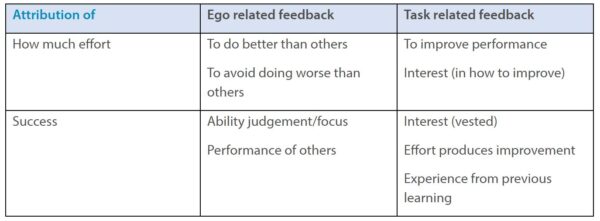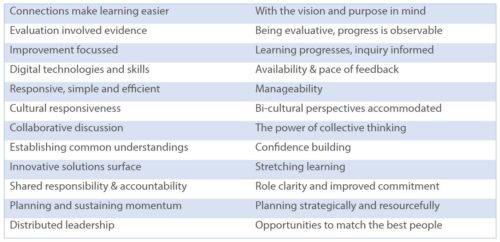Closing the feedback loop
By Steve Edwards on September 25, 2017 in Leadership
“A healthy school is an improving school.”
Agreement rippled through the group of principals, then silence fell. Although it wasn’t just silence. It was a group of committed leaders reflecting on what had just been said. How healthy is our school? Is our school an improving school? How do we know?
This blog looks at one small but significant element of a healthy school – the power of feedback – and how schools deliberately use it to improve.
Feedback is a consequence of performance It requires tasks and events to occur within a culture or expectation that improvement is always possible.(Clarke, Timperley, Hattie, Unlocking Formative Assessment, 2003).
Honest and reliable feedback enables improvement and should cause thinking. (Wiliam, Embedded Formative Assessment, 2011).
Closing the feedback loop places an emphasis on processes that return feedback information to the source in order to generate ongoing development. It sits within other processes such as teacher inquiry, school review, reporting and the biggie, effective teaching and learning. How does feedback enhance the healthiness of learning for all ākonga? The following examples highlight feedback loops across quite different settings
We begin with an example from a Kāhui Ako.
Feedback loops to and from stewardship groups
There is a tradition in education of hierarchical reporting. One level in the system reports to the next level up. Information flows upwards and informs leaders. To what extent does this information loop back?

One Kāhui Ako Stewardship Group set themselves a clear purpose – to provide effective feedback that reflects progress information supplied to them and informs future planning. It’s a participatory role that shares the responsibility of achieving progress for students. Progress reports sent up are returned with constructive feedback. This does not conflict with management roles, it informs and supports them. The feedback loop opens the system so outcomes can be informed by previous performances.

The process is familiar, manageable and time efficient. Two page workstream summary reports are prepared using a template. Headings include;
Progress to date
Successes
Challenges
Recommendations.
The design team noted the following benefits of this approach:
Reduces the top down perspective of governance because all layers are focussed on improvement.
Accountability is shared – it is our responsibility not just the teachers’ or principals’.
Transparent and honest feedback is returned to those who prepared the information and who seek it, not just the leader.
Honest feedback based on actual evidence creates opportunities for improvement. Defensive protection of information can hide genuine improvement potential.
Inclusive pronouns are used – we, us and our.
Collaborative discussion occurs system-wide.
Feedback is encouraged that is responsive and appreciative rather than directive and judgemental.
Feedback loops between secondary and primary schools
How well prepared for their secondary years are primary students? Are they on track? How do we know? One simple approach is becoming more common due to the impact of Kāhui Ako.
Returning NCEA results to the primary schools students have attended can inform those contributing schools about a range of important questions. High level feedback such as this would be of interest to all the contributing school teachers. What does the information suggest? What stories can be seen within the information?
How effective was our school in preparing these students for NCEA success at level 2 NCEA?
To what extent did the end of year 8 National Standards overall teacher judgements match the NCEA level 2 results?
What does the NCEA data show? Are there any themes for primary schools to consider?
What surprises are there and how do we respond to them?
What other information can be fed forward (primary to secondary) and fed back (secondary to primary) and for what purpose?
Closing the feedback loop in classroom teaching and learning
The provocation Teach less better (of unknown origin) conveys a worthy point. To what extent do we expect and enable students to discuss the feedback they receive from their teacher, peer or other significant contributors, so meanings can be clarified and, most importantly, adjustments made to their future learning?
Providing time to achieve clarity about learning takes time. There is a balance between moving learning forward and ensuring understanding, and this decision is usually in the domain of teachers. Should it be? Checking in with learners and co-constructing the pace of learning means the responsibility for maintaining this balance is shared.
Effective and specific feedback enables students to use that feedback to improve their own learning outcomes by using the skills of self-regulation. The students shift the responsibility of learning towards themselves and move away from reliance on the teacher. Does the feedback we give students enable them to move forward?
Do we provide sufficient time for students to work with feedback? If we do, how are students supported or guided? How do they learn to learn?
Checking in the mirror
With conviction teachers may say, “I do this now.” They are probably correct but respectfully we ask the mirror question, is this your espoused theory or your theory in action? How do we know? Would our students see it this way?
When setting up feedback loops with and for student learning, we need to ask if the feedback focuses on the learning task or the ego? Dylan Wiliam (2011) helps to clarify the difference for us through research findings.
Ego and learning task related feedback

Wiliam, D. Embedded Formative Assessment. p110. Solution Tree Press. 2011.
Closing the feedback loop – what teachers and leaders noticed.
Teaching professionals reflected on the feedback processes used within classrooms and across their schools. The following benefits were identified and came from a collaborative café hui. It’s a compelling list and more can be added.

Call to action
How healthy is your school or setting? Can you identify strong and purposeful feedback loops that feed your systems with innovative thinking? Can your colleagues? Keep it simple so your line of sight remains crystal clear.
What about your students? Do they have time to use feedback and develop the skills of self-regulation?
You’ll have your own stories and examples of feedback loops to enhance learning. What are they? How can you champion them in your own school, kura or Kāhui Ako?
Effective feedback causes thinking. It should be focused and it should provide clarity about future development.
Get in touch with Steve to learn more
Other articles you might like
Strengthening student assessment capabilities to increase learner agency
I am the new kid on the block at Evaluation Associates | Te Huinga Kākākura Mātauranga.
There’s lots of talk about appraisal in schools at the moment.
